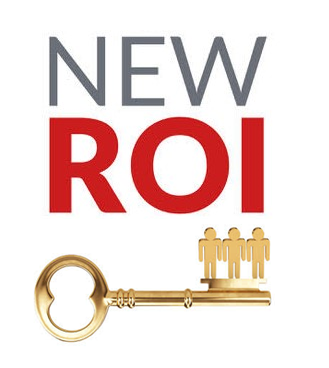The ability to bounce back from adversity is an important quality to possess. This is true in sports, in business, and in everyday life.
Some people call this quality toughness; some call it grit. Another term for this quality is resilience.
This article is part of a series that is dedicated to exploring the contribution of human capital assets (people!) to the value of a business. If you’re just joining us, welcome to The NEW ROI: Return on Individuals.
There are vast bodies of research that discuss the linkages between being resilient, being happy, and having less stress. This also creates a positive feedback loop where being happy and having less stress increases one’s resilience.
While resilience is not necessarily something you’re hard-wired with, it can be developed.
But what does it mean to be resilient and what measurable benefit does that bring to an organization?

This article is part of a series that is dedicated to exploring the contribution of human capital assets (people!) to the valuation of a business. If you’re just joining us, welcome to The New ROI: Return on Individuals.
To understand what it means to be resilient and how that quality translates to the world of business, workplace behavior expert and frequent contributor to the New ROI series, Dave Nast, and I had the pleasure of visiting with renowned expert on resilience, Cheryl Hunter.
Cheryl Hunter is known as the go-to expert on resilience. She is a speaker, author and high-performance coach who works with companies, schools and individuals to help create transformative change.
Check out this two-minute video to meet Cheryl.
Cheryl learned resilience from her own experience. While traveling abroad as a teenager, she was abducted by two criminals who held her captive, assaulted her, and left her for dead. Hunter survived this life-changing event, turned her life around, and has dedicated herself to helping others to turn their lives and businesses around.
Cheryl is regularly called upon by major media to provide expert commentary, and her work has been profiled in CNN, Fast Company, Forbes, U.S. News & World Report. Cheryl’s TED talks have been viewed hundreds of thousands of times. Her signature TED talk is at the end of this article.
Becoming Friendly With Failure
Henry Ford said, “failure is the opportunity to begin again more intelligently.” Hunter agrees, adding, “Resilient entrepreneurs and employees espouse the counter-intuitive premise that the key to success is none other than failure.
”Resilience is the ability to not only begin again after adversity, but to do so with no loss of passion, purpose, or power.” – Cheryl Hunter
Hunter believes that there are ‘nuggets of gold’ in every failure, and she encourages people to ‘hack your failures’ by reverse-engineering them to understand your common themes and responses so you can learn from your past failures.
Why Leaders Should Care About Resilience
Boxer, Mike Tyson once said, “Everyone has a plan until you get hit in the face.” How one responds to that punch in the face requires resilience.
It’s been said that there are only two certainties in this world: death and taxes. I would add another: change.
The speed of business as well as the speed of life continues to accelerate rapidly, and that creates changes in how we work, how we communicate, how we travel, and how we receive information, just to name a few. People need to be able to adapt and thrive amid constant change, so it doesn’t come at them like the punch in the face that takes them out.
Smart leaders understand that elements of psychology and behavioral dynamics can have a tremendous impact on an organization.
For example, we’ve already demonstrated that organizations that foster a culture of trust earn higher returns and we’ve already demonstrated that happy people are more productive. Keeping people in these higher states of ‘best-self’ really is good for business.
But Hunter warns that while a positive mindset is helpful, happiness and positivity alone aren’t the key to resilience, stating, “Blind-faith positive thinking doesn’t serve anyone. That starts to verge upon magical thinking, which can actually make matters worse. As much as we don’t like the fact, things can and will go wrong, and occasionally bad things happen to good people.”
According to Hunter, “If you can anticipate what will predictably go wrong, you’ll be well-equipped to build a failsafe plan to weather future failures.
“The key to resilience is to move through failure with velocity.” – Cheryl Hunter
Cheryl goes on to add, “This is critical thinking and planning that we can do either as individuals or collectively in an organization, business, or enterprise.”
The Bottom Line on Resilience
Leaders who would contemplate an investment in resilience training and education would naturally want to understand the measurable ROI. According to Cheryl, the two biggest results are increased engagement and increased employee retention.
Employee turnover is not only disruptive, it’s expensive. We’ve previously discussed the cost to replace employees, so it suffices to say that with increased retention comes the avoided costs associated with turnover.
Regarding engagement, Gallup finds that two thirds of U.S. workers were not engaged in their jobs. As Gallup notes, “they are also more likely to miss work and change jobs when new opportunities arise.”
Dave Nast provides the following sobering statistics regarding the impact of employee engagement:
- Disengaged workers cost the US about $500B/year in lost productivity.
- 80% of employees that are dissatisfied with their direct manager are disengaged.
- 46% of new hires fail within 18 months, 89% of those failures are due to poor culture fit.
- Engaged employees are 31% more productive, create 37% more sales, and are 3x’s as creative and innovative.
- Companies where the majority of the workforce are engaged improved operating income by 51% over companies with a majority of disengaged employees.
- Organizations with a higher number of actively engaged employees have an average of 147% higher earnings per share then the norm.
- Engaged employees are 87% less likely to leave a company than disengaged employees.
- Companies with a highly engaged workforce have 49% less accidents onsite.
As you can see, employee engagement has real economic consequences.
In Conclusion
Learning resilience takes training, coaching, planning, and intention for people to be able to think logically and objectively at a time when our emotions are telling us to run for the hills.
Just like a seasoned fighter that has demonstrated resilience time and again can get hit in the face and execute their response plan for that potential outcome: we all need to learn how to pivot, counter-punch, get off the ropes and get back to the center of the ring so we can try again and re-focus our eyes on the big picture.
Be sure to watch Cheryl’s signature TED Talk on resilience below.
Did you enjoy this post? Share it with others who might also enjoy it!
To keep informed on all we are thinking about and collaborative thought leadership like this one, connect with us in one of the following ways: click here for our LinkedIn Group or click here for our Facebook Group. If you’d like to understand the “Why” behind this series, please click here.
Originally published at newroi.com




